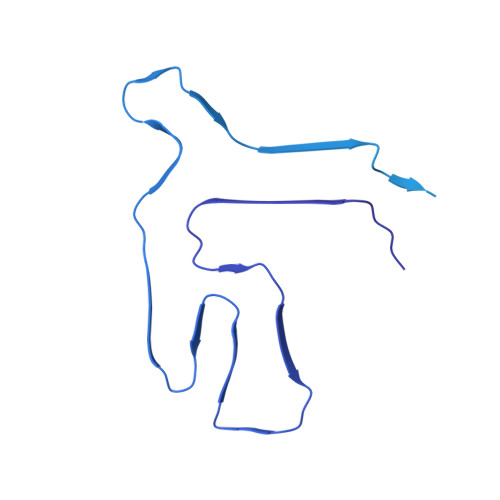TAF15 amyloid filaments in frontotemporal lobar degeneration.
Tetter, S., Arseni, D., Murzin, A.G., Buhidma, Y., Peak-Chew, S.Y., Garringer, H.J., Newell, K.L., Vidal, R., Apostolova, L.G., Lashley, T., Ghetti, B., Ryskeldi-Falcon, B.(2024) Nature 625: 345-351
- PubMed: 38057661
- DOI: https://doi.org/10.1038/s41586-023-06801-2
- Primary Citation of Related Structures:
8ONS - PubMed Abstract:
Frontotemporal lobar degeneration (FTLD) causes frontotemporal dementia (FTD), the most common form of dementia after Alzheimer's disease, and is often also associated with motor disorders 1 . The pathological hallmarks of FTLD are neuronal inclusions of specific, abnormally assembled proteins 2 . In the majority of cases the inclusions contain amyloid filament assemblies of TAR DNA-binding protein 43 (TDP-43) or tau, with distinct filament structures characterizing different FTLD subtypes 3,4 . The presence of amyloid filaments and their identities and structures in the remaining approximately 10% of FTLD cases are unknown but are widely believed to be composed of the protein fused in sarcoma (FUS, also known as translocated in liposarcoma). As such, these cases are commonly referred to as FTLD-FUS. Here we used cryogenic electron microscopy (cryo-EM) to determine the structures of amyloid filaments extracted from the prefrontal and temporal cortices of four individuals with FTLD-FUS. Surprisingly, we found abundant amyloid filaments of the FUS homologue TATA-binding protein-associated factor 15 (TAF15, also known as TATA-binding protein-associated factor 2N) rather than of FUS itself. The filament fold is formed from residues 7-99 in the low-complexity domain (LCD) of TAF15 and was identical between individuals. Furthermore, we found TAF15 filaments with the same fold in the motor cortex and brainstem of two of the individuals, both showing upper and lower motor neuron pathology. The formation of TAF15 amyloid filaments with a characteristic fold in FTLD establishes TAF15 proteinopathy in neurodegenerative disease. The structure of TAF15 amyloid filaments provides a basis for the development of model systems of neurodegenerative disease, as well as for the design of diagnostic and therapeutic tools targeting TAF15 proteinopathy.
- MRC Laboratory of Molecular Biology, Cambridge, UK.
Organizational Affiliation:
















